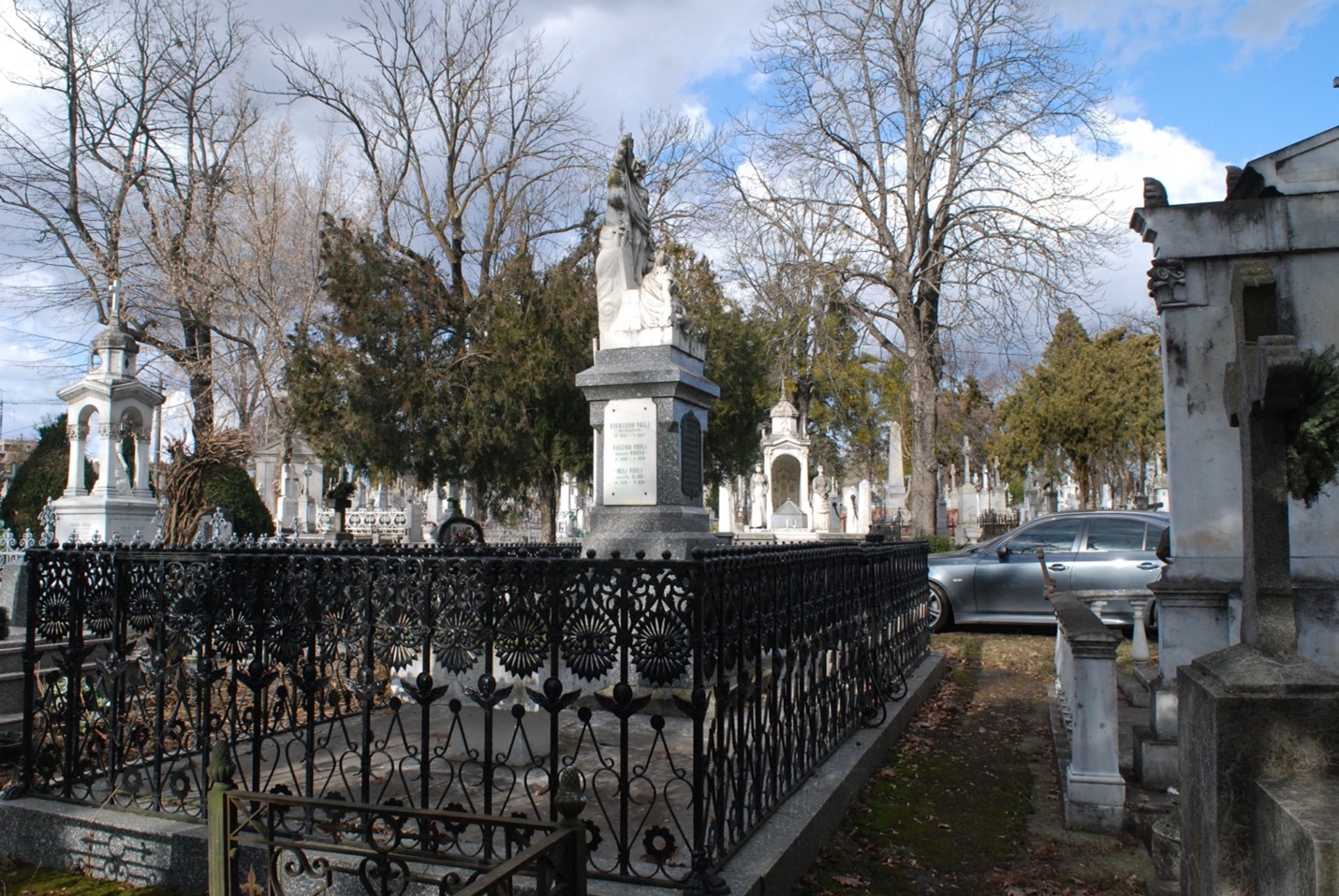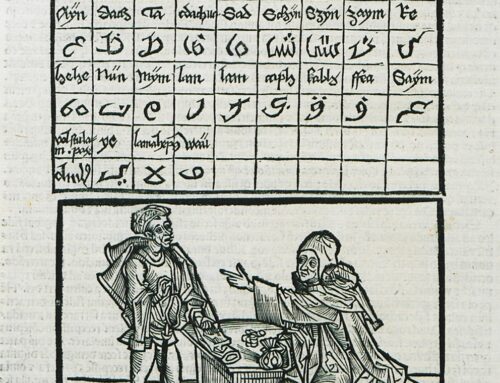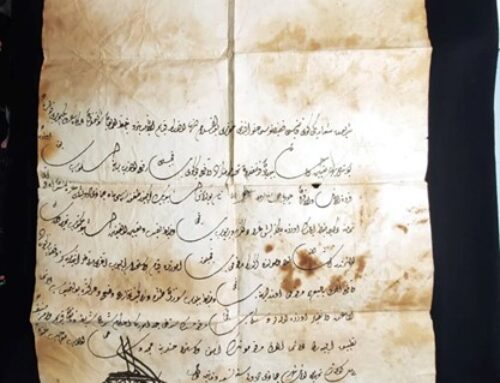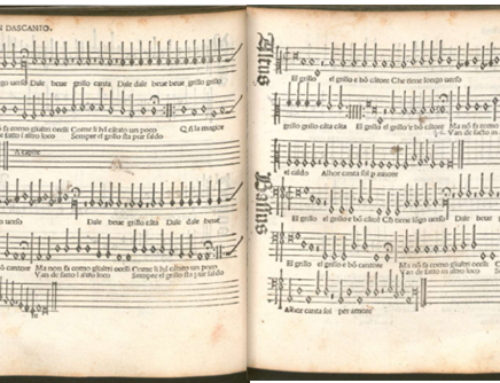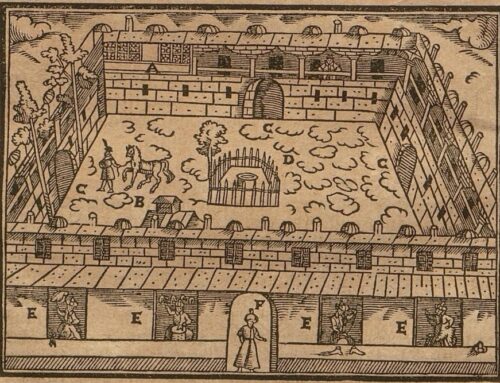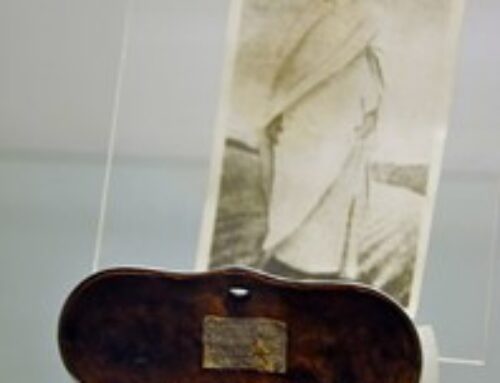Cover Image: Eternity Cemetery, Iaşi, The Family Tomb of the Pavli Family
The family tomb, whose photographic glimpse is provided here, captures some 300 years of history of a single immigrant family from the region of Gjirokastra (now South Albania) to Iaşi, Romania and is a good case of family preservation through integration. On a central plot (Plot 4 / I, row 3) at the western side of the central church of the Eternity Cemetery (Cimitirul Eternitatea) in Iaşi the impressive, fenced tomb of the Pavli (or Pavlou) family captures the eye of the visitor. The tomb is slightly elevated from the ground, covered with slabs of white marble with a grey marble contour. The central part of the family tomb there is a sculpture elevated on an over-two-metres-high basis revetted with slabs of grey-back marble with white spots. The statue portrays Christ’s Resurrection dominates over the surrounding tombs. The statue portrays the Resurrected Christ rising from the Sepulchre. Christ stands upright, lifts his right hand in a gesture of greeting and holds a gilded cross with his left hand. He is mantle covers only his lower torso part, leaving the rest of His strong body exposed. At His left side, a standing angel crosses hands over the chest in a gesture of supplication. Before their feet, two of the custody’s soldiers are seated on the ground. The one at Christ’s right side appears to have just woken up and, while looking at Christ with awe and fear, lowers his right hand in a gesture of surprise and puts his left at the feet of the other soldier who is still sleeping in an attempt to wake him up. The statue is made of white marble, on whose basis the artist left his signature in capital letters “A. TUSINI ǀ2 ODESSA.” I do not know any other information about the sculptor, other than he was also working on funerary commissions.
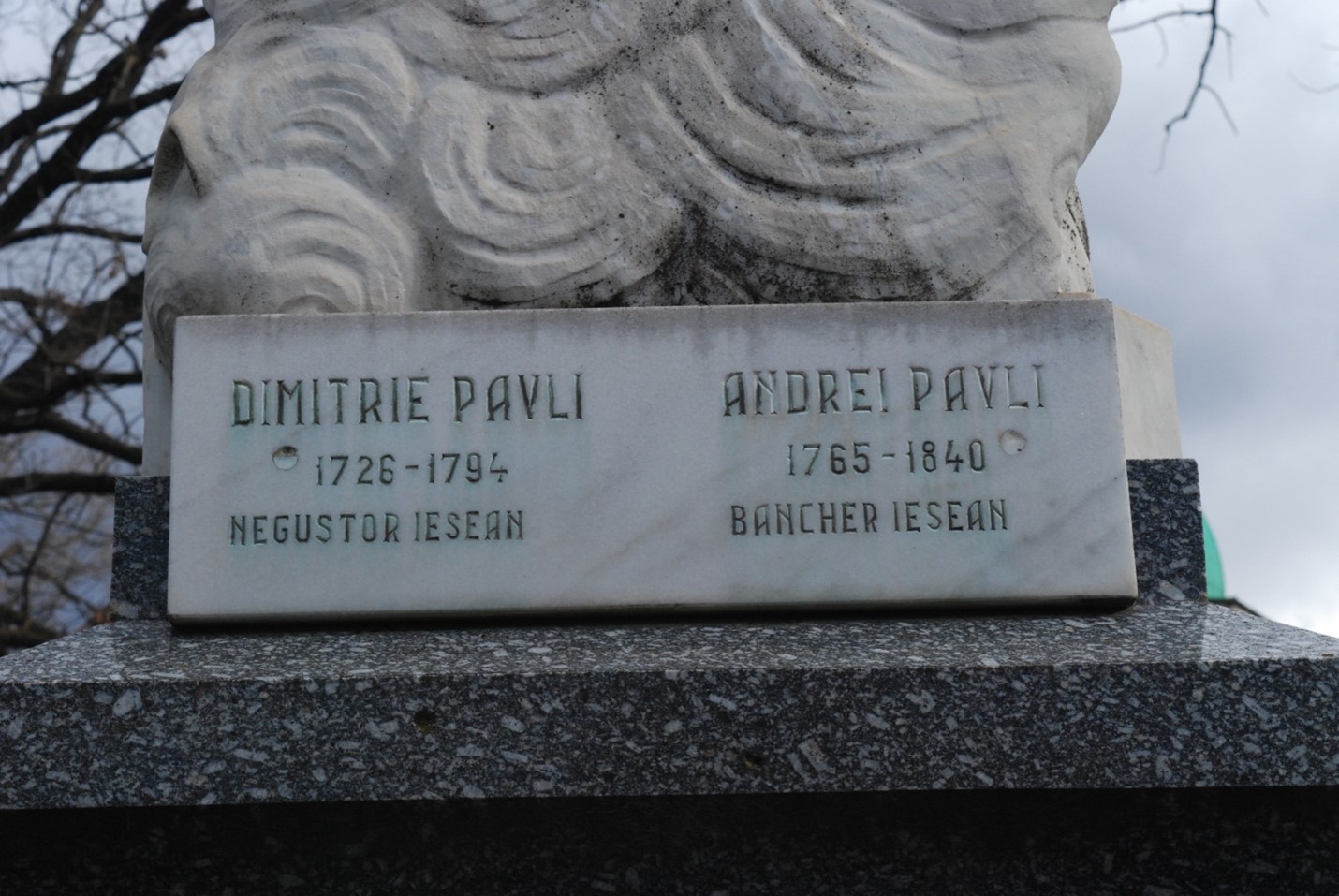
Fig. 2 Eternity Cemetery, Iaşi, The oldest inscription from the Family Tomb of the Pavli Family, commemorating the eldest members of the branch in Iaşi, Dimitrios (Dimitrie) and Andreas (Andrei)
A number of inscriptions at the sides of the sculpture’s elevated base reveal the early history of the Pavli family (Rusu et al. 1995, 165). I am transcribing them below:
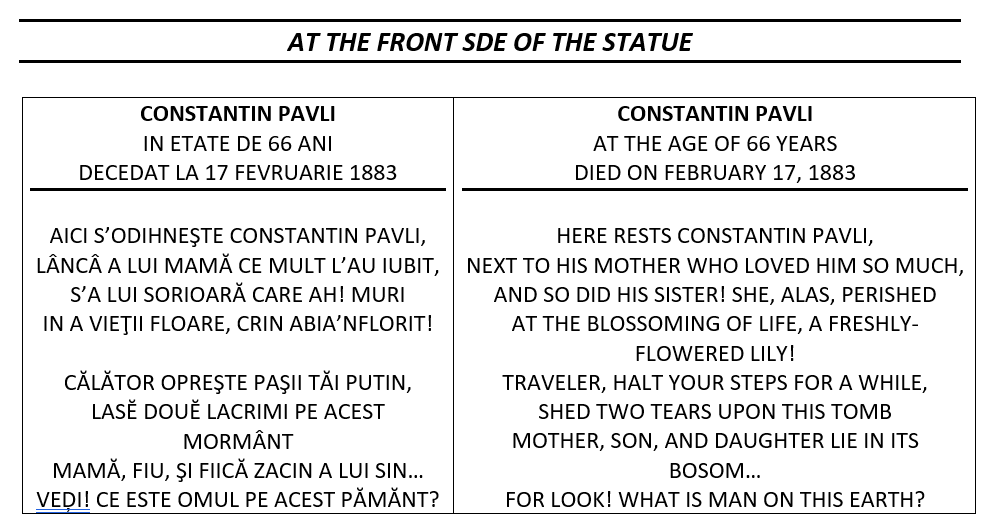
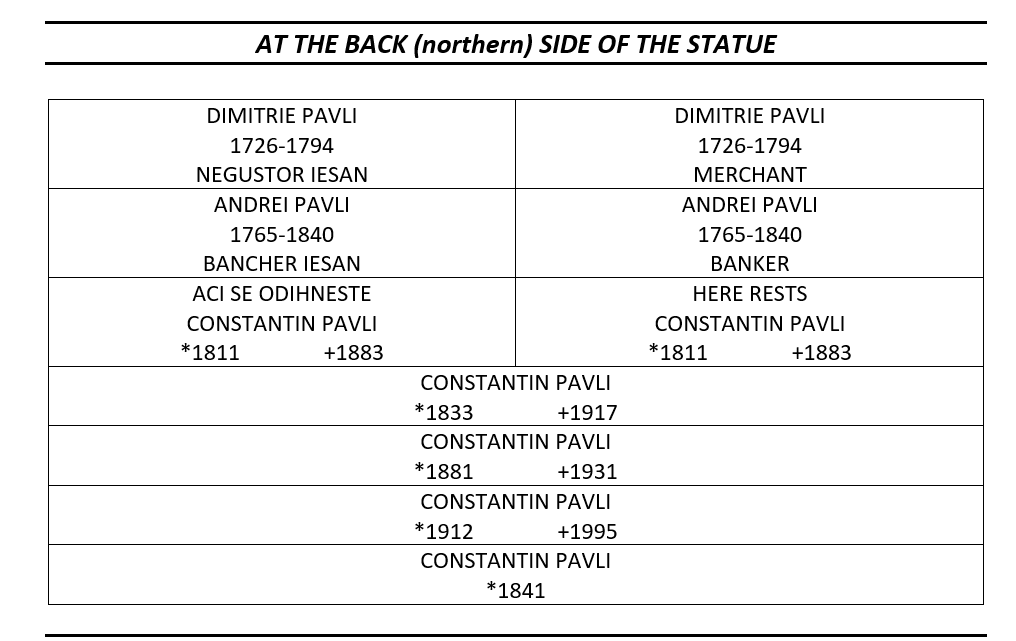
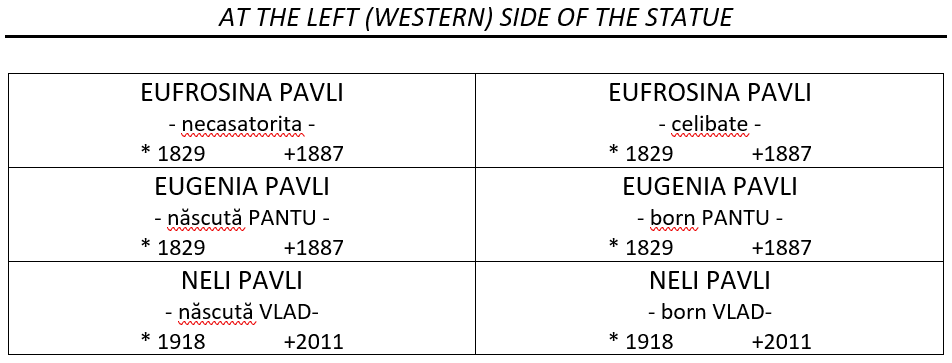
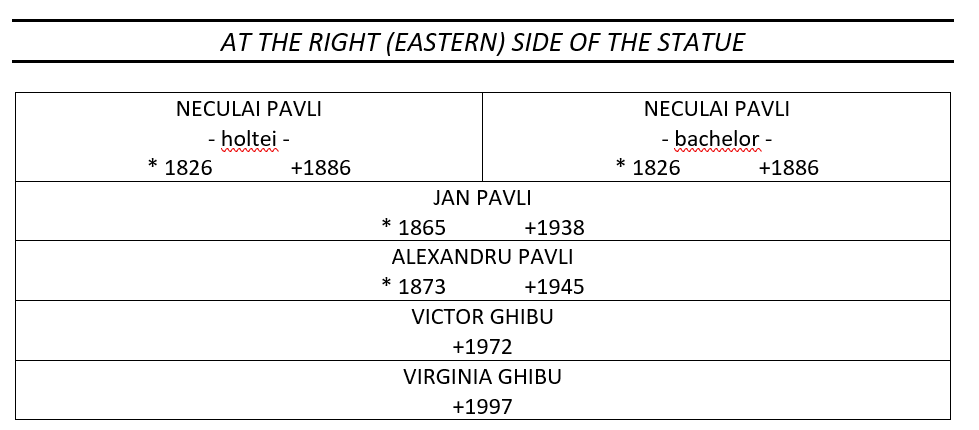
The family’s funerary inscriptions are only one piece of information about the early family history and, most likely, not the most accurate. The thread of this family’s history is unrolled through two other, perhaps more reliable sources. The first of these sources is from the diocesan codex of Dryinoupolis and Gjirokastra (Giakoumis 2020, Acts 30, 43-45, 48 and 67), in which the early history of the Pavlou / Pavli family is revealed (20.08.1775-15.04.1786), as well as the whereabouts of three of its members, Dimitrios I and his two sons, Dimitrios II and Andreas. All three are mentioned as executioners, intermediaries or wardens of two testaments, whose business also relates to Iaşi. The third source, written on the basis of several archival sources, is a publication (Zahariuc 2022, 437-67), in which the entrepreneurial activity of Andrea(s) Pavli, as well as aspects of family history are discussed.
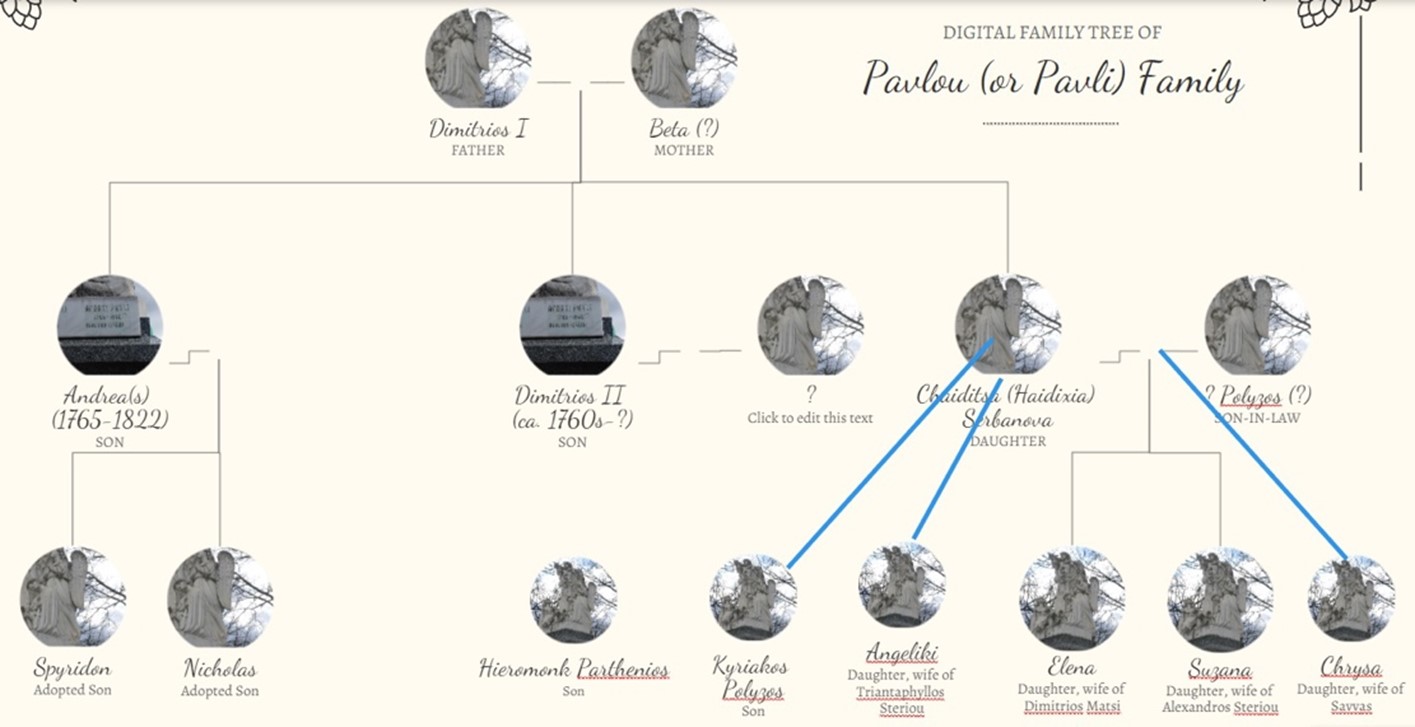
Graph 1: Pavli (or Pavlou) Family Tree
Synthesizing the latter two sources a part of the family tree can be reconstructed (Graph 1). The whereabouts of the first members of the family between 20.08.1775 and 15.04.1786 are indicated a series of acts of the Diocesan Codex of Dryinoupolis and Gjirokastër (Giakoumis 2020, Acts 30, 43-45, 48 and 67). It is provided below, in Table 1 and should be read as instances, rather intervals, in which a person remained in the same place:
| # | Date | Person | Place | Reference |
| 1. | 20.08.1775 | Dimitrios I | Iaşi | Giakoumis 2020, Act No. 30 |
| 2. | 28.06.1778 | Dimitrios II | Gjirokastër | Giakoumis 2020, Act No. 43 |
| 3. | 28.06.1778 | Andreas | Ioannina | Giakoumis 2020, Act No. 43 |
| 4. | 11.07.1778 | Dimitrios II | Gjirokastër | Giakoumis 2020, Act No. 44 |
| 5. | 11.07.1778 | Andreas | Iaşi | Giakoumis 2020, Act No. 44 |
| 6. | March 1781 | Dimitrios II | Gjirokastër | Giakoumis 2020, Act No. 45 |
| 7. | March 1781 | Andreas | Gjirokastër | Giakoumis 2020, Act No. 45 |
| 8. | 23.07.1781 | Dimitrios II | Gjirokastër | Giakoumis 2020, Act No. 48 |
| 9. | 23.07.1781 | Andreas | Gjirokastër | Giakoumis 2020, Act No. 48 |
| 10. | 15.04.1786 | Andreas | Iaşi | Giakoumis 2020, Act No. 67 |
Table 1: The whereabouts of the two first generations of the Pavli Family (1775-1786).
The first member of the family who appears to have immigrated to Iaşi at ca. 1760s (Zahariuc 2022, 441 and n. 10) was Dimitrios I Pavli (1726-1794), originating from Gjirokastër, South Albania. He was married to a woman probably called Beta with whom they had at least one daughter, Chaiditsa, and two sons, Dimitrios (II) and Andreas. While Dimitrios I was still in Iaşi in 1775, his sons and daughter lived between their home town, Gjirokastër and Ioannina. Andreas must have joined his father in Iaşi within a few shortly years after the end of the Russian-Turkish war of 1769-1774, travelling back and forth between the Balkans (including Gjirokaster) and Iaşi in service of the family trade network and banking business. In Iaşi, Andreas engages in commerce and banking, but often appears as a warden in the executions of testaments of deceased person with some dealing in Iaşi, where the Pavli family and Andreas, in particular, is established as a “merchant, man of honour, the best capitalist,” as Alexandru Beldiman would characterise him (cited in Zahariuc 2022, 438). In the course of the end of the eighteenth and the first two decades of the nineteenth century Andrea(s) Pavli (or Pavlou) would become a point of reference in most commercial and banking operations involving the region of Moldavia and Iaşi with the Ottoman and/or the Habsburg Empires. He amassed such a wealth that he was rather coerced to financially support the revolutionary movements of the Philike Hetaireia (Society of Friends) working secretly against the Ottoman Empire, a support that almost ruined him. He died as a single, childless man on 8 November 1822 in Chisinau and was buried in one of the local churches (Zahariuc 2022, 456).
Had the Iaşi family line ended with Andrea(s) Pavli’s death in Chisinau, the Pavli family tomb in Iaşi’s Eternity cemetery would be irrelevant to the family originating from Gjirokastër. Before his death, Andrea(s) Pavli adopted two sons, Spyridon and Nicholas, sons of Dimitrios Velas also from Epiros, who received a portion of his property by force of the deceased’s testament. Spyridon Pavli returned to Iaşi in 1826 or earlier and continued to develop the village of his father-by-adoption. No family name of Spyridon nor Nicholas is recorded in the family tomb mentioned at the beginning of this visual reflection. Undoubtedly, at the current stage of research there are many more questions than answers. Have the relics of Dimitrios I and Andrea(s) Pavli been buried and translated in the Eternity cemetery of Iaşi? If not, were they recorded out of family memory? If yes, why other attested family names, those of Andrea(s)’ two adopted sons, were not mentioned in the family tomb?
Be this as it may, this visual reflection combining hard evidence from Iaşi’s Eternity cemetery with archival sources from Albania and Romania elucidates some clues to investigate why, in the case of this family, 300 years of family history memory has been preserved, contrary to all other names of their fellow Gjirokastër compatriots. The financial strength of the Iaşi magnate seems to provide an inadequate case. The continuation of the family lineage to date, as shown from the last descendant buried in the same family tomb (until 2020), Neli Pavli (1918-2011). The key to the preservation of 300 years of memory of an immigrant family seems to be precisely the continuation of the family line to date. No other immigrant family from the same city has left any traces in Iaşi; they were bachelor males, who died intestate. Another clue is that the Pavli family appears to have been completely Romanianized and no traces of activity have been left after the end of the 18th century in their place of origin. For the Pavli family and the other immigrants from Epiros and Albania to Moldovallachia home and host territories appear to blur in the passing of time.
WORKS MENTIONED
Giakoumis, Konstantinos. 2020. Ο Εκκλησιαστικός Κώδικας Δρυϊνουπόλεως και Αργυροκάστρου (1760-1858), Tirana: University College LOGOS.
Rusu, Olga, Ostap, Constantin, Pricop, Adrian, Macarie, Gherghe, Bucos, Constantin, Rusu, Constantin-Liviu.1995. Cimitirul Eternitatea Iasi. Iasi: Cronica.
Zahariuc, Petronel. 2022. “Un capitalist din Moldova Vechiului Regim: Andrei Pavli.” In Istoria ca pasiune. Studii oferite profesorului Alexandru-Florin Platon la împlinirea a 65 de ani, edited by Petronel Zahariuc, Laurenţiu Rădvan and Liviu Pilat, 437-67. Iaşi: Editura Universităţii „Alexandru Ioan Cuza” din Iaşi.


